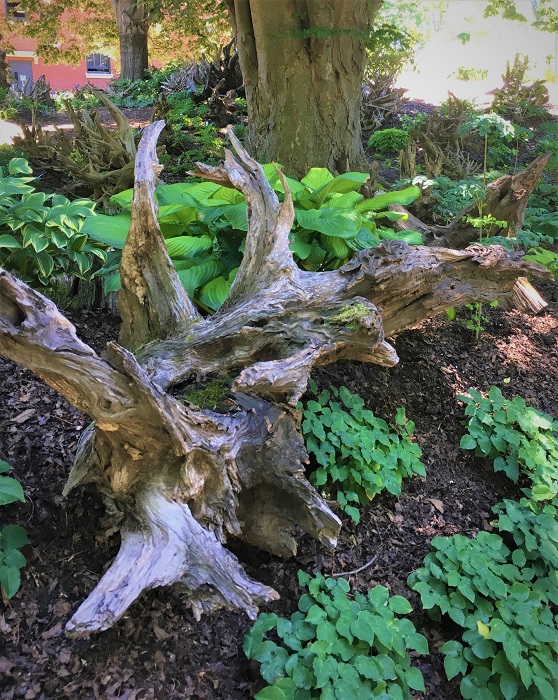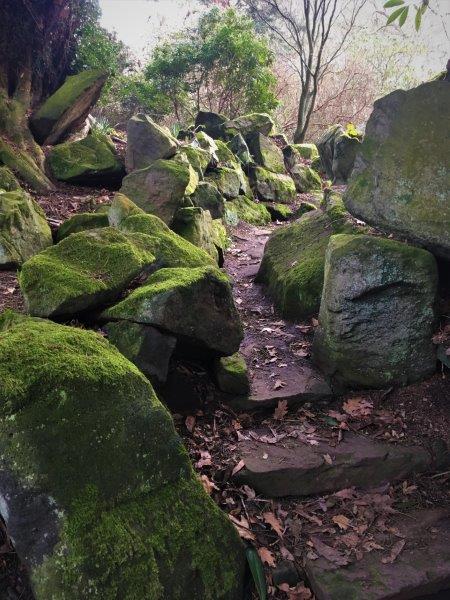
“Quell’orror bello che attristando piace” – that beautiful horror which delights while it saddens (Italian poet Ippolito Pindemonte)
Stumpery. First time I heard the word was one of those finger-snap moments, a cerebral light bulb thing.

I mean, who’da thought it was a thing? I mean, we’ve been doing it all along, right?
But here I am, nearly thirty years later, actually standing in the oldest stumpery in the world, and thinking about how to enlarge my own backyard collection of tree trunks, stumps, and gnarly limbs (and how my kids will have a hell of a time dismantling or burning it all down when I’m gone).
Granted, like other very leisurely First-World approaches to ornamental gardening, it isn’t everyone’s cup of tea -some folks simply can’t untidy their gardens. But in this eco-minded and pollinator-friendly age’s pushback against industrial-grade manicured gardens, anyone with a hard-to-plant shaded spot can use this as a starting point. Judgemental inquiries can be brushed aside with an arched eyebrow and just the word. “It’s a stumpery, my dear.”
Mine got started as a natural focal point in my new shade garden where everything was either too high or too low, nothing mid-point to grab attention or create the mood I wanted. So I propped up the top parts of some cedar and cypress trees and hung Spanish moss and allowed woodland vines to clamber. Then added a couple of wizened old stumps which now sport mosses and interesting mushrooms. Next thing I knew, a sleek lizard was propped up on one, looking at a fat old toad down in the mulch, both eyeing the same bugs.
To brighten the summer-gloomy shade spot, I added a splashy water feature (which attracts wildlife) and a silvery-blue gazing ball.
Added a few lichen-encrusted logs, and planted Hosta, Liriope, Solomon seal, creeping saxifrage (strawberry geranium), Heuchera, Hellebores, winter-berried Nandina…

NATURALLY EASY
Not that this is mind-boggling; creating special places for fallen limbs, logs, and stumps may be a hot trend in botanic gardens worldwide, but’s been done for centuries on smaller scales. Lots of folks who couldn’t afford to grind an old tree trunk into sawdust planted Liriope, ivy, and moss around it, adding a little gnome or some concrete mushrooms to give neatnik neighbors a clue. I once prompted frustrated neighbors with a gnarly fallen tree in their front yard to just tuck plants around it – and they ended up adding holiday lights as well!
I was inclined this way by landscape architecture professor Neal Odenwald, who had connected the trunks of trees in his large yard with curving rows of fallen debris, big stuff at the bottom and smaller limbs and leaves on top. It quickly composted into rich, moist soil for azaleas and other shade plants and created more interest while cutting his mowing and leaf raking time by half.
It’s called hügelkultur – a German term for building raised beds by piling all sorts of wood, both rotting and fresh, topped with leaves, other compostable garden and kitchen debris, and a little compost or dirt thrown on top to kick off the enriching decay. My Mississippi guerilla gardening friend Jesse Lee Yancy made one, atop an otherwise impossible-to-plant paved area in his celebrated streetcorner garden, from materials scrounged around his neighborhood.
An easier way to start is to simply leave a dead tree in place, as long as it won’t hit anything when it falls. In forest ecology this is called a “snag” and provides crucial nesting and food sources for many dozens of important creatures from owls and flying squirrels to native pollinating bees, carpenter ants, beetles, grubs, and everything that they eat or are eaten by.
GOING WHOLE HOG
But a true stumpery – the most atmospheric approach of all – is made of one or more tree stumps placed on their sides or even upside-down to show the root structure, with added logs, driftwood or large pieces of bark.
It’s a lot like a rockery walk… only a LOT easier to plant (and not as slippery when wet).

I’ve seen them recreated in nearly every big flower show, and at various botanic gardens across the UK and US (largest is on a Puget Sound island near Seattle; an impressive new one is at the back of the St. Louis Botanic Garden; let me know about any you’ve admired). And all are in good company – Britain’s King Charles has an incredible one, and I have visited and photographed dozens in creative smaller gardens.

The acknowledged first and oldest stumpery, a Victorian horticultural oddity in north England, was created in 1856 by one of the founders of the Royal Horticulture Society as an exaggeration of the glories of Nature. I was overawed on my first wander through its prehistoric-feeling walls and arches of tightly packed stumps and logs covered with mosses, countless varieties of ferns, hostas, ivy, Heucheras, cylamenen and other spring bulbs, and all sorts of other woodland plants.

Check out this short video I put together of my recent tour of the old stumpery:
So….I’ve joined a fervent tribe of naturalistic gardeners who line paths with fallen limbs, pile wood into mounds or walls, or display unusual pieces, roots-up, all accented with woodland plants. And, every time a big storm blows through, my truck and I prowl the area for just the right new piece.
Doesn’t take much to get started. In fact, it can look TOO natural. Which is sorta the point. Not to get too philosophical here, stumperies and other natural decay scenes appeal to people who appreciate how death and dilapidation are undermined by regeneration and beautiful new growth; their bizarre disorder offers not-so-subtle aspirations of infinity.
Meanwhile my own stumpery may not be up to King Charles’ head gardener’s royal standards, but it’s in scale with my little garden, looks good, and is an inviting habitat for toads, beetles, lizards, pollinators, and other creatures – including me.
Otherwise homeless baby skink, and an “insect hotel” added feature
While visiting the new RHS Bridgewater Botanic Garden near Manchester, UK, I came across the most fantastic accessory ever – an almost-lifesize Ent, shepherd of the forest (remember them from The Lord of the Rings?)…










I have a few stumps too and they’re great fun…adding good architecture for herbaceous plants, especially in shady areas.
LikeLike
So fun, relaxing, and rewarding. ‘Specially when I come across new wildlife that otherwise would be homeless!
Love to see some photos of yours…
LikeLike
This inspires me!
LikeLike
Magical
What about termites?
LikeLike
Termites CAN be troublesome in some climates. But generally in such a mixed media there will be predators for them as well. And predators for the predators… Good point though.
LikeLike
I started mine several years ago. I am so enjoying watching the plant material evolve. Arisaema, cyclamen, Epimedium,Hosta, all ferns, brunnera, tiarella, heuchera, Corydalis, and especially Saxifraga species fill in quickly. Loving the waves of mushrooms that overtake the stumps. Small-scale, but very worthwhile.
LikeLike
Scholar and a gentleman, Sir Helms. Thanks. Seems we are both still having fun with non-linear approaches to gardening! Send a pic when ya get a chance.
LikeLike
Are you old enough to remember the redwood burl fad? When I was a kid, there were several vendors selling all sorts of redwood burl sculpture, furniture and touristy trinkets on Highway 9. There were many more farther north. Some was very tacky. Some of the sculpture was very well done. Only the biggest and most renowned of these vendors remains and a redwood sculpture studio. The original artisan passed away a few years ago. Even though it is tacky, it is an important component of our local culture. I am pleased that it is still there.
LikeLike
I DO remember that funky stuff (I was stationed in San Diego -Navy Band – in the early 70’s, did a lot of PR traveling up and down the entire West Coast…).
I still have a seashell/encrusted lamp from those macrame plant hanger days…
LikeLiked by 1 person
Oh GADS! Perhaps you should not admit to that.
LikeLiked by 1 person